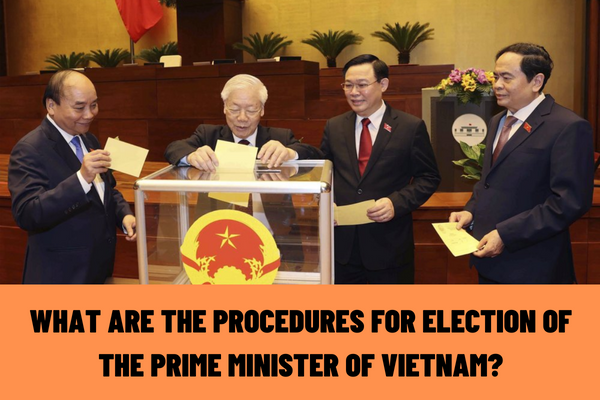What are the procedures for election of the Prime Minister of Vietnam? What are the tasks and powers of the Prime Minister of Vietnam?
What are the procedures for election of the Prime Minister of Vietnam?
Pursuant to Article 35 of the National Assembly's Session Regulations promulgated together with Resolution 71/2022/QH15 stipulating that the Prime Minister's election shall be implemented as follows:
- The President of Vietnam presents the list of nominees for the National Assembly to elect the Prime Minister of Vietnam.
- In addition to the list proposed by the President, National Assembly deputies have the right to nominate or nominate themselves for the position of Prime Minister, and the person nominated for election has the right to withdraw from the list of candidates.
- National Assembly deputies discuss at the National Assembly Delegation; The President of the National Assembly may meet with the Heads of the National Assembly Delegation and invite the State President to attend to discuss related issues.
- The President of Vietnam shall report to the National Assembly on the explanation and reception of opinions of the National Assembly deputies discussed at the National Assembly Delegation.
- The National Assembly Standing Committee shall submit to the National Assembly for decision the list of candidates introduced by the National Assembly deputies or self-nominated (if any).
- The National Assembly discusses and votes on the list to elect the Prime Minister
- The National Assembly establishes a vote counting committee.
- The National Assembly elects the Prime Minister by secret ballot.
- The Vote Counting Committee reports the vote counting results and voting results.
- The National Assembly Standing Committee submits to the National Assembly a draft resolution to elect the Prime Minister
- Parliament discussed.
- The National Assembly Standing Committee shall report to the National Assembly on the explanation and reception of opinions of the National Assembly deputies and the revision of the draft resolution.
- The National Assembly votes to approve the draft resolution.
- The Prime Minister takes the oath.

What are the procedures for election of the Prime Minister of Vietnam? What are the tasks and powers of the Prime Minister of Vietnam? (Image from the Internet)
What are the procedures for dismissal of the Prime Minister of Vietnam?
Pursuant to Clause 1, Article 43 of the National Assembly's meeting rules promulgated together with Resolution 71/2022/QH15, in case of dismissal of the Prime Minister of Vietnam, the following procedures must be followed:
- The President proposes to the National Assembly to dismiss the Prime Minister from office.
- National Assembly deputies discuss at the National Assembly Delegation; The President of the National Assembly may meet with the Heads of the National Assembly Delegation to discuss related issues;
- Representatives of agencies or competent persons shall report to the National Assembly on the explanation and reception of opinions of National Assembly deputies at the National Assembly Delegation;
- Parliament discussed. Before the National Assembly deliberations, the person proposed to be relieved of duty, the person proposed to be removed from office or removed from office has the right to express opinions;
- The National Assembly establishes a vote counting committee;
- The National Assembly relieves and dismisses or approves the proposal for removal from office or dismissal by secret ballot;
- The Vote Counting Committee reports on the vote counting results and voting results;
- The Standing Committee of the National Assembly shall submit to the National Assembly a draft resolution on dismissal or dismissal or approval of the request for relief or dismissal;
- The National Assembly discusses;
- The National Assembly Standing Committee shall report to the National Assembly on the explanation and absorption of opinions of the National Assembly deputies and the revision of the draft resolution;
- The National Assembly votes to approve the draft resolution.
What are the tasks and powers of the Prime Minister of Vietnam?
Pursuant to Article 98 of the 2013 Constitution, the Prime Minister of Vietnam has the tasks and powers as follows:
- To lead the work of the Government; to lead the formulation of policies and organize the implementation of laws;
- To lead and take responsibility for the work of the state administration system from the central to the local level, ensuring the consistency and continuity of the national administration system;
- To submit to the National Assembly for approval proposals on the appointment, relief from duty or dismissal of Deputy Prime Ministers, Ministers or other members of the Government; to appoint, relieve from duty or dismiss Deputy Ministers or officials of equal rank of ministries or ministerial-level agencies; to approve the election and relief from duty, and to decide on the transfer or dismissal of Chairpersons and Vice Chairpersons of the People’s Committees of provinces or centrally run cities;
- To suspend the implementation of, or annul the documents, of Ministers, Heads of ministerial-level agencies, People’s Committees, Chairpersons of the People’s Committees of provinces or centrally run cities that contravene the Constitution, laws or documents of state agencies at higher levels; to suspend the implementation of resolutions of the People’s Councils of provinces or centrally run cities that contravene the Constitution, laws or documents of state agencies at higher levels and, at the same time, to propose the Standing Committee of the National Assembly to annul them;
- To decide on and direct the negotiation of, and to direct the conclusion, and accession to, or ratification of, treaties within the scope of the tasks and powers of the Government; to organize the implementation of treaties to which the Socialist Republic of Vietnam is a contracting party;
- To make reports to the People through the mass media on important issues falling within the competence of the Government and the Prime Minister.
Resolution 71/2022/QH15 takes effect on March 15, 2023.
LawNet
